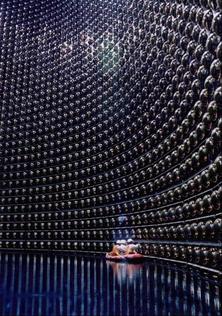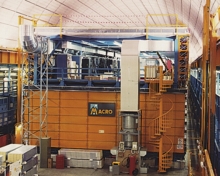Research Interests:
Neutrino Physics and Particle Astrophysics
My research specializations are neutrino physics and particle astrophysics. Specific topics include neutrino oscillation, nucleon decay, and the search for dark matter. In terms of neutrino oscillation, I was deeply involved in the discovery and measurement of neutrino mass by observing the flavor-changing oscillations of atmospheric neutrinos using the Super-K detector in Japan. This work was recognized in 2015 with the Nobel Prize in Physics. I also participated in the now-completed MACRO and K2K experiments, both of which provided independent confirmation of the neutrino oscillation effect. In addition to continuing studies of atmospheric neutrinos with Super-K, I am a member of the T2K (Tokai-To-Kamioka) experiment. For nucleon decay, an ongoing goal of Super-K is to search for baryon number violation, by searching for proton decay and related processes. These processes are predicted by Grand Unified Theories that unite the strong, weak, and electromagnetic interactions. This has been a major research thrust in my research group at BU, which graduated four PhD students with work in this area. With dark matter, I am involved in the search for dark matter using a technique based on cryogenic noble liquids. The particular detector that my group helped build is called MiniCLEAN, which is located at SNOLab in Sudbury, Ontario.
Selected Publications:
"Search for proton decay via p→e+pizero and p→mu+pizero in 0.31 megaton·years exposure of the Super-Kamiokande water Cherenkov detector”, K. Abe, et al., Phys. Rev. D95, 012010 (2017).
“Establishing Atmospheric Neutrino Oscillation”, T. Kajita, E. Kearns, M. Shiozawa, Nucl. Phys. B908, 14 (2016)
“Indication of Electron-Neutrino Appearance from an Accelerator-Produced Off-Axis Beam”, K. Abe, et al., Phys. Rev. Lett. 107, 041801 (2011).
“Astrophysical Neutrino Telescopes”, A.B.McDonald, C. Spiering, S. Schonert, E.T. Kearns, and T. Kajita, Rev. Sci. Instrum. 75, 293 (2004).
“Evidence for oscillation of atmospheric neutrinos”, Y. Fukuda, et al., Phys. Rev. Lett. 82, 1562 (1998).
For a full list of publications, please see the attached CV.
Education:
- Massachusetts Institute of Technology, B.S. 1982
- Harvard University, A.M. 1984, Ph.D. 1990
Honors/Awards:
- American Physical Society W.K.H. Panofsky Prize (2021)
- Breakthrough Prize in Fundamental Physics (2015)
- Fellow, American Physical Society
In the news:
- Ed Kearns wins the 2021 W.K.H. Panofsky Prize in Experimental Particle Physics
- Super-K and T2K awarded Breakthrough Prize in Fundamental Physics
- Neutrino Nobel has BU connections
- T2K experiment confirms electron neutrino appearance
- First Long-Baseline Neutrino in T2K
- Professors Kearns and Sandvik Named APS Fellows
Research Descriptions:
Neutrino Physics and Astrophysics

As a sequel to the combined effort of the two earlier deep underground ring-imaging detectors, IMB and Kamiokande, Super-Kamiokande started recording data deep inside a lead and zinc mine in the Japanese Alps in 1996. The detector is a 40-meter high by 40-meter diameter stainless steel tank, filled with 50,000 tons of ultra-pure water. The walls of the tank are lined with 11,200 photomultiplier tubes, each an enormous 50 centimeters in diameter. One half of the surface of the tank is covered by photosensitive material. These tubes record the Cherenkov light from charged particles as they pass through the water.
Physicists in the US and in Japan designed Super-K to search for, in part, the radioactive decay of the proton, a rare event never before observed. Detecting proton decay would confirm the Grand Unified Theory of particle physics.
Though Super-K has yet to detected a single candidate, it observed something equally intriguing: convincing evidence that neutrinos have mass. Because neutrinos carry no charge, they rarely interact with other particles. Billions go through each of us every second without effect. But since Super-K is so large, it detects a handful of these neutrinos each week. Using the data collected by Super-K, researchers including Boston University physicists Jim Stone (US co-spokesman), Larry Sulak and Ed Kearns confirmed results from the two precursor experiments that about half the neutrinos expected were unseen.
Neutrinos come in three species – the tau neutrino, the muon neutrino, and the electron neutrino. Super-K discovered that these neutrino species transform into each other. If oscillations occur, muon neutrinos could transform into tau neutrinos, and the missing neutrinos observed by Super-K would be explained. This was documented in the 1999 Ph.D. thesis of Boston University graduate student Mark Messier. Quantum mechanically, for these oscillations to occur, the neutrino must have mass. Several experiments since this revelation in 1998 have reinforced this interpretation.
The discovery of massive neutrinos has forced theorists to rethink the Standard Model of particle physics; neutrino mass is not anticipated in this most accurate and predictive of theories. Further, with mass, the neutrinos in the universe account for nearly as much mass as all the stars. Hence, they would influence the formation of galaxies in the early universe. This discovery is the first indication of new physics beyond the Standard Model.
The MACRO Experiment: Monopole Astrophysics and Cosmic Ray Observatory
The deep underground MACRO detector operated at the Laboratori Nazionali del Gran Sasso in Abruzzo, Italy from 1990 to 2000. MACRO had a geometrical acceptance of 10,000 square meters at an average depth of 3.8 kilometers of water equivalent under the mountainous overburden of the Gran Sasso d'Italia. The MACRO detector was used to research several topics. The specialty of MACRO was the search for magnetic monopoles: particles with bare north or south magnetic charge. These particles are a natural consequence of Grand Unified Theories, which also predict that the monopole will be very massive, perhaps 10 to the power 16 GeV. Such particles can only be produced by the intense energies available during the big bang. MACRO operated like a giant Time-Of-Flight counter to detect the unique signature of a slow moving but penetrating massive particle. It was equipped with tanks of liquid scintillator, planes of streamer tubes and plates of track etch material in the hopes of recording a convincing signature from a single candidate event. MACRO's high-resolution tracking and timing were also used to perform high statistics measurements of cosmic ray muons; in particular, the scintillator timing was used to distinguish upward going muons produced by neutrino interactions in the rock. This was an opportunity to investigate the possible flavor oscillation of massive neutrinos as suggested by the atmospheric neutrino puzzle, and MACRO was the first experiment to independently confirm the atmospheric neutrino oscillation signal seen by Super-Kamiokande.
 Physics (Internal)
Physics (Internal)

